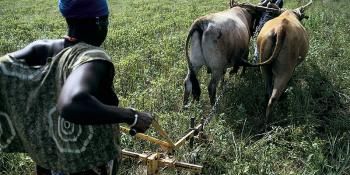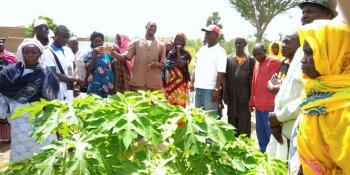What relationship does cassava starch have with precipitation?

A study aims to determine the importance of rainfall variability in the content of starch cassava harvested in Colombia.
In Colombia, the production of cassava is over two million tons, a number that may seem low compared to the nearly forty million tons in Nigeria, the largest cassava producer; but that does not downplay the cultivation of this root in the country, considered by FAO as an opportunity for developing countries to strengthen their rural economy and increase the income of producers, by converting the raw material of relatively low cost in high-value starch.
According to a report from the Central Bank of Colombia, the cultivation of cassava is considered of great importance for food security because it contains one of the largest amount of energy in the world, and is recognized important when there is poor harvest of other food products.
For its part, FAO reported that cassava cultivation has big advantages, such as high yields per hectare, tolerance to drought and degraded soils, and great flexibility in planting and harvesting. As an energy source, cassava is highly competitive: the root contains more starch, by dry weight, than almost any other food crop, and the starch is easy to extract using simple technologies.
About the MADR-CIAT/CCAFS Agreement
This agreement, carried out under CCAFS activities in Latin America, seeks to enhance the competitiveness of the Colombian agricultural sector through the implementation of policy instruments, strengthening the investment of resources for research, technological development and innovation.
A project for the first time brings together national government, academia, research centers, NGOs and farmers in production chains of different crops.
In the Colombian north coast, more than fifty percent of the national production of cassava is located here, and starch extraction has become an important source of income for smallholder farmers, in response to the high demand for the food industry and as a marketing option in addition to the fresh market sale. However, low starch content may cause decreases in payments to farmers; therefore, it is essential to ensure that enough amounts of starch in the plant in order for farmers to earn higher incomes from its sale.
It is important for these producers the know when the rainy season arrives to plant their crops. But what is the importance of variability in rainfall for cassava starch? An analysis made by researchers at the International Center for Tropical Agriculture (CIAT) under the MARD-CIAT/CCAFS Agreement (a.k.a Convenio) sought to evaluate the relationship between fluctuations in the content of cassava starch and seasonal patterns of rainfall with climate information of the National Meteorological Service (IDEAM in Spanish).
As a result of the analysis between 2009 and 2013, a seasonal pattern was detected by the percentage of starch received in the processing plant "Almidones de Sucre" located in the municipalty of Corozal, Sucre department, where the cassava starch for industrial use decreases were related to dry or low rainfall months. So, after the driest months of the year in December, January and February, and during the rainy months, the starch content decreased.
 Evaluating this correlation, the researchers developed a statistical model relating variables derived from rainfall to the percentage of cassava starch delivered to the processing plant Almidones de Sucre in the Colombian Caribbean.
Evaluating this correlation, the researchers developed a statistical model relating variables derived from rainfall to the percentage of cassava starch delivered to the processing plant Almidones de Sucre in the Colombian Caribbean.
The result of this modeling showed that there is a relationship between the decrease in starch and high rainfall during the last month before harvest. Similarly, increased rainfall, after a dry period during the last three months before harvest, brings lower starch content in cassava; the report explains it as the plant, after going through a period of water stress and then have more availability of water, creates new sprouts, moving the nutrients or 'assimilates' from the root to the top of the plant (stem and leaves) in a natural process known as translocation.
This study, whose preliminary results are already available, allows to evaluate the importance of rain at harvest time considering the potential of cassava for industrial use. The study also recommends producers take into account the environmental conditions of planned harvest date in order to prevent that precipitation near this time to generate a decrease in starch content of cassava. Producers also have to consider that they must achieve a balance between harvesting before the arrival of the rains and avoid prolonged storage of seeds for subsequent plantings to start a wet or high rainfall period.
Thus, MARD-CIAT/CCAFS continues joining efforts, resources and institutional capacities to strengthen the resilience of agriculture to climate variability and change, and improve the efficiency of resource use in production systems.
More information
Download the Info Note: Cassava starch content and its relationship with rainfall (also available in Spanish)
Website of MADR-CIAT/CCAFS Agreement
José Luis Urrea is Communications Officer for CCAFS Latin America. Patricia Moreno is researcher of Decision and Policy Analysis Area at CIAT.



